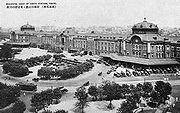
Japanese Government Railways
Encyclopedia

Rail transport
Rail transport is a means of conveyance of passengers and goods by way of wheeled vehicles running on rail tracks. In contrast to road transport, where vehicles merely run on a prepared surface, rail vehicles are also directionally guided by the tracks they run on...
system directly operated by the central government of Japan
Japan
Japan is an island nation in East Asia. Located in the Pacific Ocean, it lies to the east of the Sea of Japan, China, North Korea, South Korea and Russia, stretching from the Sea of Okhotsk in the north to the East China Sea and Taiwan in the south...
until 1949. It is a predecessor of Japanese National Railways
Japanese National Railways
, abbreviated or "JNR", was the national railway network of Japan from 1949 to 1987.-History:The term Kokuyū Tetsudō "state-owned railway" originally referred to a network of railway lines operated by nationalized companies under the control of the Railway Institute following the nationalization...
and the Japan Railways Group.
Name
The English name "Japanese Government Railways" was what the of Japan (established in 1920) used to call its own and sometimes the ministry itself as a railway operator. Other English names for the government railways include Imperial Japanese Government Railways and Imperial Government Railways, which were mainly used prior to the establishment of the ministry. This article however covers the railways operated by the central government of Japan from 1872 to 1949 notwithstanding the official English name of the system of each era.Network
By the end of World War II in 1945, the Japanese Government Railways operated on the main Japanese islands of HonshūHonshu
is the largest island of Japan. The nation's main island, it is south of Hokkaido across the Tsugaru Strait, north of Shikoku across the Inland Sea, and northeast of Kyushu across the Kanmon Strait...
, Hokkaidō
Hokkaido
, formerly known as Ezo, Yezo, Yeso, or Yesso, is Japan's second largest island; it is also the largest and northernmost of Japan's 47 prefectural-level subdivisions. The Tsugaru Strait separates Hokkaido from Honshu, although the two islands are connected by the underwater railway Seikan Tunnel...
, Kyūshū
Kyushu
is the third largest island of Japan and most southwesterly of its four main islands. Its alternate ancient names include , , and . The historical regional name is referred to Kyushu and its surrounding islands....
, Shikoku
Shikoku
is the smallest and least populous of the four main islands of Japan, located south of Honshū and east of the island of Kyūshū. Its ancient names include Iyo-no-futana-shima , Iyo-shima , and Futana-shima...
and Karafuto
Karafuto Prefecture
, commonly called South Sakhalin, was the Japanese administrative division corresponding to Japanese territory on Sakhalin from 1905 to 1945. Through the Treaty of Portsmouth, the portion of Sakhalin south of 50°N became a colony of Japan in 1905...
. The railways in Taiwan
Taiwan
Taiwan , also known, especially in the past, as Formosa , is the largest island of the same-named island group of East Asia in the western Pacific Ocean and located off the southeastern coast of mainland China. The island forms over 99% of the current territory of the Republic of China following...
and Korea
Korea
Korea ) is an East Asian geographic region that is currently divided into two separate sovereign states — North Korea and South Korea. Located on the Korean Peninsula, Korea is bordered by the People's Republic of China to the northwest, Russia to the northeast, and is separated from Japan to the...
were operated by the local Governor-General Offices and were not part of JGR.
| Year | Distance JGR adopted the metric system Metric system The metric system is an international decimalised system of measurement. France was first to adopt a metric system, in 1799, and a metric system is now the official system of measurement, used in almost every country in the world... |
|
|---|---|---|
| mi | km | |
| 1881 | 76.3131 | 122.8 |
| 1891 | 551.22 | 887.1 |
| 1901 | 822.49 | 1,323.7 |
| 1906-07: railway nationalization | ||
| 1911 | 4870.6 | 7,838.5 |
| 1921 | 6484.7 | 10,436.1 |
| 1931 | 14,574.9 | |
| 1941 | 18,400.0 | |
While the JGR was the only major operator of intercity railways after the railway nationalization in 1906-07, privately owned regional railways were also active.
The gauge
Rail gauge
Track gauge or rail gauge is the distance between the inner sides of the heads of the two load bearing rails that make up a single railway line. Sixty percent of the world's railways use a standard gauge of . Wider gauges are called broad gauge; smaller gauges, narrow gauge. Break-of-gauge refers...
of the railway was 1,067 mm (narrow gauge) with minor exceptions (184.2 km total in the peak years of 1936-38) of 762 mm gauge lines.
History

Railway Nationalization Act
The brought many of Japan's private railway lines under national control. The Diet of Japan promulgated the Act on March 31, 1906. The Act was repealed by Article 110 of the Japan National Railway Reform Act of 1988, which formed the modern Japan Railways Group....
in 1906. In 1920, the Ministry of Railways was established.
In 1949, JGR was reorganized to become a state-owned public corporation
Japanese public corporations
Although the Japanese economy is largely based on private enterprise, it does have a number of government-owned corporations, which are more extensive and, in some cases, different in function from what exists in the United States.- History :...
named the Japanese National Railways
Japanese National Railways
, abbreviated or "JNR", was the national railway network of Japan from 1949 to 1987.-History:The term Kokuyū Tetsudō "state-owned railway" originally referred to a network of railway lines operated by nationalized companies under the control of the Railway Institute following the nationalization...
.
Timeline
- June 12, 1872 - Provisional opening of TokyoTokyo, ; officially , is one of the 47 prefectures of Japan. Tokyo is the capital of Japan, the center of the Greater Tokyo Area, and the largest metropolitan area of Japan. It is the seat of the Japanese government and the Imperial Palace, and the home of the Japanese Imperial Family...
-YokohamaYokohamais the capital city of Kanagawa Prefecture and the second largest city in Japan by population after Tokyo and most populous municipality of Japan. It lies on Tokyo Bay, south of Tokyo, in the Kantō region of the main island of Honshu...
railway (Shinagawa StationShinagawa Stationis the first major station south ofTokyo Station and is a major interchange for trains operated by JR East, JR Central, and Keikyu. The Tōkaidō Shinkansen and other trains to the Miura Peninsula, Izu Peninsula and the Tōkai region pass through here...
- Yokohama StationSakuragicho Station, is a railway station located in Naka Ward, Yokohama, Japan.-Lines:Sakuragichō Station is served by the following lines.*East Japan Railway Company**Keihin-Tōhoku Line / Negishi Line*Yokohama Municipal Subway**Blue Line -Station layout:...
) - October 14, 1872 - Formal opening of Tokyo-Yokohama railway (ceremony at ShimbashiShiodome Station (JNR)was a freight train station of the Japanese National Railways in Minato, Tokyo, Japan. The freight terminal was originally named and served as the first railway terminal of Tokyo between 1872 and 1914.-History:...
and Yokohama Stations) - October 1, 1907 - Completion of nationalization of 17 private railways under 1906 Railway Nationalization ActRailway Nationalization ActThe brought many of Japan's private railway lines under national control. The Diet of Japan promulgated the Act on March 31, 1906. The Act was repealed by Article 110 of the Japan National Railway Reform Act of 1988, which formed the modern Japan Railways Group....
- December 20, 1914 - Opening of Tokyo StationTokyo Stationis a train station located in the Marunouchi business district of Chiyoda, Tokyo, Japan, near the Imperial Palace grounds and the Ginza commercial district....
- November 1, 1925 - Inauguration of the Yamanote Loop LineYamanote LineThe is commuter rail loop line in Tokyo, Japan, operated by East Japan Railway Company . It is one of Tokyo's busiest and most important lines, connecting most of Tokyo's major stations and urban centres, including the Yūrakuchō/Ginza area, Shibuya, Shinjuku, and Ikebukuro, with all but two of its...
- April 1, 1943 - Inclusion of Karafuto prefecturalKarafuto Prefecture, commonly called South Sakhalin, was the Japanese administrative division corresponding to Japanese territory on Sakhalin from 1905 to 1945. Through the Treaty of Portsmouth, the portion of Sakhalin south of 50°N became a colony of Japan in 1905...
lines into national system - February 1, 1946 - Official exclusion of SovietSoviet UnionThe Soviet Union , officially the Union of Soviet Socialist Republics , was a constitutionally socialist state that existed in Eurasia between 1922 and 1991....
-occupied Karafuto lines from national system - June 1, 1949 - Establishment of Japanese National Railways, i.e. end of Japanese Government Railways
- April 1, 1987 - Privatization of JNR, establishment of seven JR companies
Historical operators of JGR
Before the establishment of the Japanese National Railways as a public corporation on June 1, 1949, the Japanese Government Railways were operated by the governmental agencies. The table below shows the historical operators of the JGR.Translated names of ministries may not be official. Names of the operating department generally mean "department (or office, section, agency) of railways" or like.
| Date of establishment |
Ministry | Department | Note |
|---|---|---|---|
| 1870-04-19 | 鉄道掛 (Tetsudō-gakari) | in charge of construction only | |
| 1870-08-06 | |||
| 1870-12-12 | |||
| 1871-09-28 | 鉄道寮 (Tetsudō-ryō) | First railway opened in 1872. | |
| 1877-01-11 | 鉄道局 (Tetsudō-kyoku) | ||
| 1885-12-22 | |||
| 1890-09-06 | 鉄道庁 (Tetsudō-chō) | ||
| 1892-07-21 | |||
| 1893-11-10 | 鉄道局 (Tetsudō-kyoku) | ||
| 1897-08-18 | 鉄道作業局 (Tetsudō-sagyō-kyoku) | Tetsudō-kyoku survived as an administrative body for private railways till 1908. | |
| 1907-04-01 | 帝国鉄道庁 (Teikoku-Tetsudō-chō) | ||
| 1908-12-05 | 鉄道院 (Tetsudō-in) | Government Railways were commonly called . | |
| 1920-05-15 | Government Railways were commonly called . | ||
| 1943-11-01 | 鉄道総局 (Tetsudō-sōkyoku) | ||
| 1945-05-19 | |||
Tourism promotion
One of the roles of the Japanese Government Railways was to attract foreign tourists to Japan. In 1930, the government created the as a section of the Japanese Government Railways (Ministry of Railways). The Board printed and distributed picture posters and English guidebooks overseas and encouraged development of resort hotels at home. The Board was dissolved in 1942, following the breakout of the Pacific WarPacific War
The Pacific War, also sometimes called the Asia-Pacific War refers broadly to the parts of World War II that took place in the Pacific Ocean, its islands, and in East Asia, then called the Far East...
in 1941.
Notable people
- Inoue MasaruInoue MasaruViscount was the first `Director of Railways` in Japan and is known as the "father of the Japanese railways".He was born into the Chōshū clan at Hagi, Yamaguchi...
- Head of the government railways between 1871 and 1893 - Hirai Seijirō - Head of the government railways between 1904 and 1908
- Gotō Shinpei - Head of the government railways between 1908 and 1911
- Takejirō TokonamiTakejirō Tokonamiwas a Japanese politician who served as Home Minister of Japan and Railway Minister. Tokonami was born January 1897 in Kagoshima, and later attended the law school at the University of Tokyo...
- Head of government railways in 1920s and early 1930s - Eisaku SatōEisaku SatoThis article is about the Prime Minister of Japan. For the governor of Fukushima Prefecture of Japan of the same name, see Eisaku Satō ....
(Prime Minister of Japan in 1960s) - serves as a railway official between 1924 and 1948

